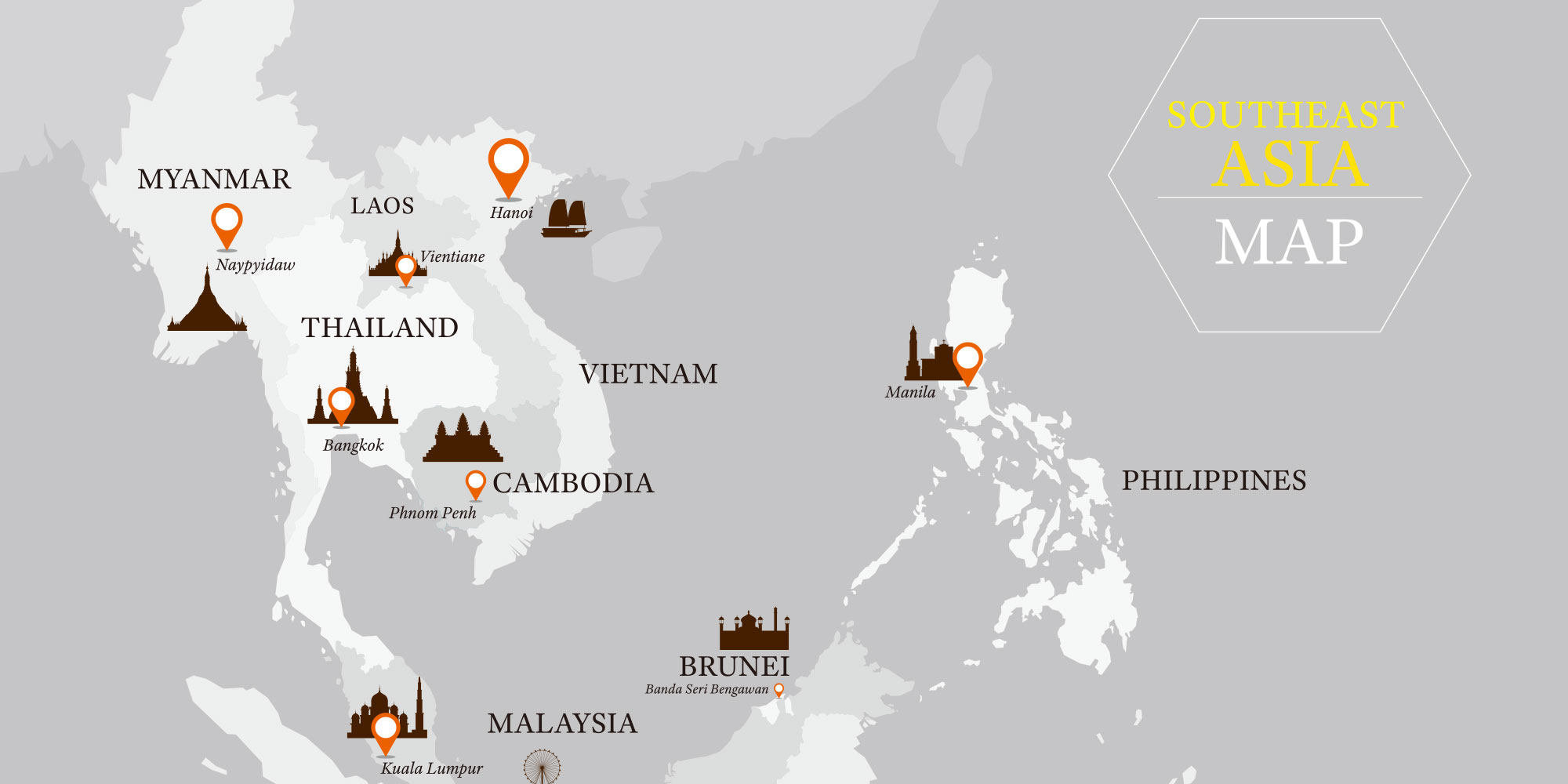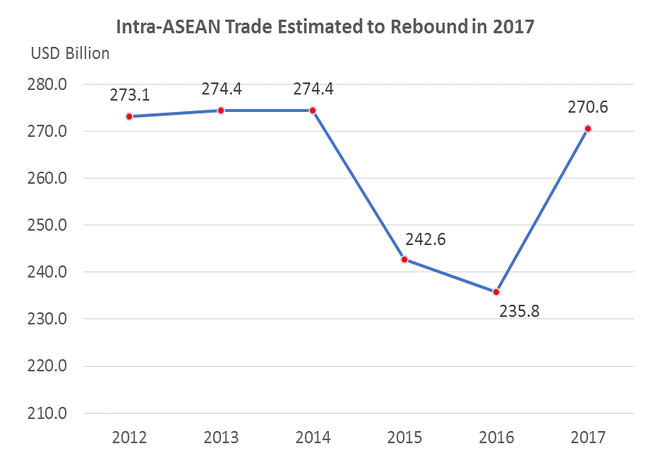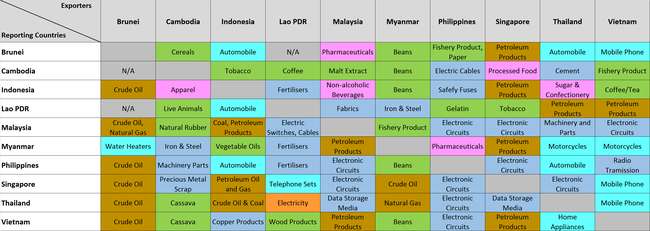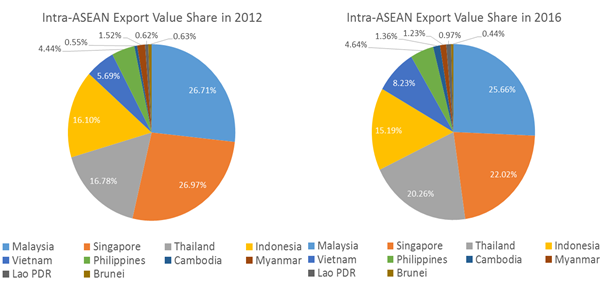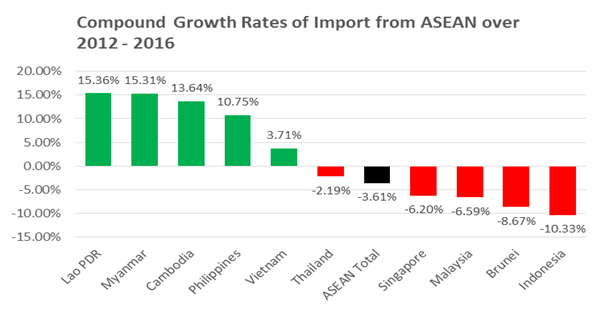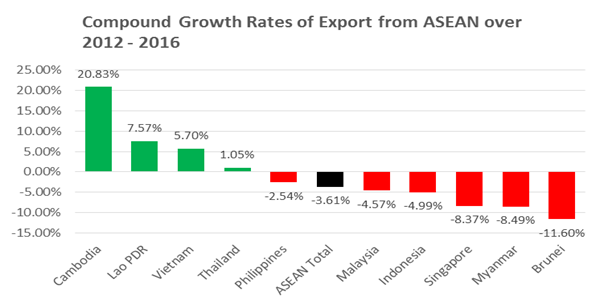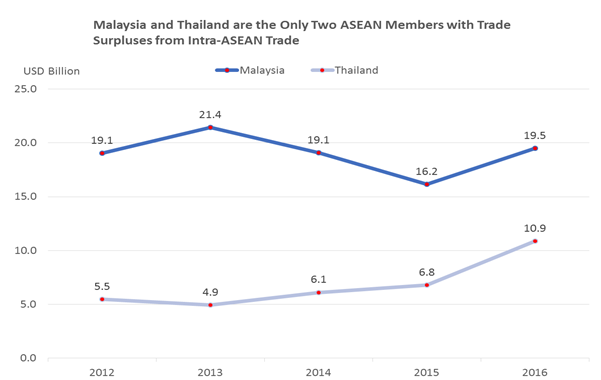Intra-ASEAN Trade Analysis
|
The Association of South East Asian Nations (ASEAN) comprises 10 members: Brunei, Cambodia, Lao PDR, Indonesia, Malaysia, Myanmar, Singapore, Thailand and Vietnam. The diverse cultures, geographic characteristics and political backgrounds of each country within ASEAN result in equally diverse trading patterns between the group’s members. |
|
Products traded range from agricultural produce, fossil fuels to advanced electronic components and devices. While Myanmar’s main export products to ASEAN peers are almost exclusively agriculture produce such as beans and Brunei’s main export products to the group is crude oil, countries like Thailand exports a wide range of products from sugar confectionery to automobiles. |
|
ASEAN members also exhibits important value-chain linkages for certain industries, creating manufacturing hubs within the region. For example, the Philippines is the main exporter of integrated electronic circuits and micro-assemblies to electronic production bases in Malaysia, Singapore, Thailand and Vietnam. On the other hand, there are also rivalries formed between ASEAN members. Both Indonesia and Thailand compete for export of automobiles to emerging markets with huge appetite for cars such as Lao PDR, the Philippines and Vietnam. |
|
In recent years, the dominance of intra-ASEAN trade by more developed members: Indonesia, Malaysia, Thailand and Singapore gave way to increasingly active trading countries in Cambodia, Lao PDR, Myanmar, the Philippines and Vietnam. Cambodia posted an impressive intra-ASEAN export growth rate of 20.8% CAGR over 2012 – 2016 while Lao PDR import from ASEAN peers surged by 15.4% CAGR over the same period. |
|
As these emerging economies participate more actively in regional trade activities, intra-ASEAN trade is expected to develop further, benefiting all members. Thailand is the prime beneficiary of these increased trade participations. The country’s trade surplus from intra-ASEAN trade surged to USD 10.9 billion in 2016 from USD 5.5 billion in 2012, boosted by double-digit growth rates of demand from emerging ASEAN peers such as Cambodia (17.5% CAGR), Lao PDR (17.5% CAGR), Myanmar (26.7% CAGR), the Philippines (16.6 CAGR) and Vietnam (11.2% CAGR) over 2012 – 2016. |
|
Intra-ASEAN Trade, One of the Most Diverse Trading Blocs in the World |
|
The Association of Southeast Asian Nations – ASEAN – are a group of countries with diverse cultural, economic, and political backgrounds. Geographically, the group ranges from landlocked Lao People’s Democratic Republic (Lao PDR) to archipelagic Indonesia. Consequently, ASEAN members exhibit equally diverse trading patterns. The group of countries’ total trade value reached a peak of USD 274.4 billion in 2014 before declining by 14.1% over 2015 – 2016 to reach USD 235.8 billion in 2016. Based on preliminary data from UN Comtrade, the group’s total trade was estimated to rebound to USD 270.6 billion in 2017, reversing the negative trend in the past recent years. |
|
|
|
Source: Calculated by UZABASE based on UN Comtrade Statistics |
|
Note: 2017 data is estimated using UN Comtrade Statistics |
|
From analysing recent trade statistics (UN Comtrade Database), we compiled the top products that ASEAN members trade with each other in the below intra-ASEAN commodities trade map. |
|
Intra-ASEAN Commodities Trade Map |
|
|
|
Table Reading Note: Myanmar’s main import product from Singapore is Petroleum Products |
|
Note: Main products are determined by % shares of total import value |
|
Source: Compiled by UZABASE based on UN Comtrade statistics |
|
|
|
ASEAN countries export a wide range of commodities from beans to automobiles to other members. Countries such as Myanmar and Brunei rely almost exclusively on exporting natural resources such as crude oil and natural gas and agricultural products such as beans. On the other hand, more developed countries such as Malaysia and Singapore export a wide range of products from agricultural produce (malt) to advanced technological products (data storage media). |
|
There are obvious value chain linkages between ASEAN members for a wide range of industries. For example: Myanmar exports crude oil to Singapore and imports back refined petroleum products from the island country’s refineries. Or the Philippines exports integrated electronic circuits and micro-assemblies to Malaysia, Singapore, Thailand and Vietnam to supply these countries’ growing electronic sectors which produce smart phones, data storage devices, telecommunication equipment, home appliances and many others. |
|
On the other hand, there are also rivalries formed between ASEAN members. Both Indonesia and Thailand compete for export of automobiles to emerging markets with huge appetite for cars such as Lao PDR, the Philippines and Vietnam. While Malaysia and Singapore are among the top suppliers of data storage media such as hard disks to Thailand. |
|
Intra-ASEAN Trade Mainly Driven by Indonesia, Malaysia, Thailand and Singapore |
|
These four countries’ combined export share and import share of intra-ASEAN trade were 83.1% and 74.0% respectively in 2016. Within these four countries, Malaysia exported the most to other ASEAN countries in 2016 at USD 60.5 billion or 25.7% of total intra-ASEAN export. On the importing side, Singapore imported the most from other ASEAN members in 2016 at nearly USD 71.0 billion or 26.2% of total Intra-ASEAN import value. |
|
|
|
Source: Calculated by UZABASE based on UN Comtrade Statistics |
|
Note: 2016 was latest data available for all ASEAN countries |
|
|
|
Source: Calculated by UZABASE based on UN Comtrade Statistics |
|
Note: 2016 was latest data available for all ASEAN countries |
|
However, the dominance of these four countries is on the decline as other members open up their economies and participate more in global and regional trade activities. Lao PDR and Myanmar’s imports from other ASEAN members grew impressively by 15.4% and 13.6% CAGRs respectively over 2012 – 2016. While most of ASEAN members’ export to other members were mostly on the decline over 2012 – 2016, Cambodia posted a surge in export revenue to ASEAN neighbours at 20.8% CAGR over the period. Total export value to ASEAN by Cambodia doubled to USD 3.2 billion in 2016 from USD 1.5 billion in 2012. This was on the back of a general decline in intra ASEAN trade value of 3.6% CARC over 2012 – 2016. |
|
|
|
Source: Calculated by UZABASE based on UN Comtrade Statistics |
|
|
|
Source: Calculated by UZABASE based on UN Comtrade Statistics |
|
Thailand and Malaysia the Only Two Countries Posted Strong Intra-ASEAN Trade Surpluses |
|
Over the period 2012 – 2016, only Thailand and Malaysia posted trade surpluses from intra-ASEAN trade. However, the two countries recorded largely different intra-ASEAN trade trends over the period. |
|
Malaysia’s intra ASEAN trade surplus recovered to USD 19.5 billion in 2016 from the three-year decline reaching USD 16.2 billion in 2015 from USD 21.4 billion in 2013. The country’s intra-ASEAN trade balance worsened in 2013 – 2015 due to the decline in export to Indonesia and Singapore. Malaysia’s export to Indonesia and Singapore declined by 18.5% CARC and 7.6% CARC over 2013 – 2016 before recovering in 2017. However, despite the decline in export value to main trade partners within ASEAN, Malaysia’s intra-ASEAN import also declined by 7.0% CARC over 2012 – 2016. As a result, Malaysia’s intra-ASEAN trade balance held up within this period. |
|
On the other hand, Thailand’s intra-ASEAN trade surplus continued to increase over the same period to reach USD 10.9 billion in 2016 from USD 5.5 billion in 2012, at a CAGR of 18.6%. This was aided largely by an export growth rate of 5.7% CAGR combined with an import decline of 2.2% CARC over the period. Thailand’s export continues to enjoy great growth from demands from emerging markets within ASEAN such as Cambodia (17.5% CAGR), Lao PDR (17.5% CAGR), Myanmar (26.7% CAGR), the Philippines (16.6% CAGR) and Vietnam (11.2% CAGR) from 2012 – 2016. These countries import a wide range of products from Thailand such as cement (Cambodia), petroleum products (Lao PDR), motorcycles (Myanmar), automobiles (the Philippines) and home appliances (Vietnam). |
|
|
|
Source: Calculated by UZABASE based on UN Comtrade Statistics |
